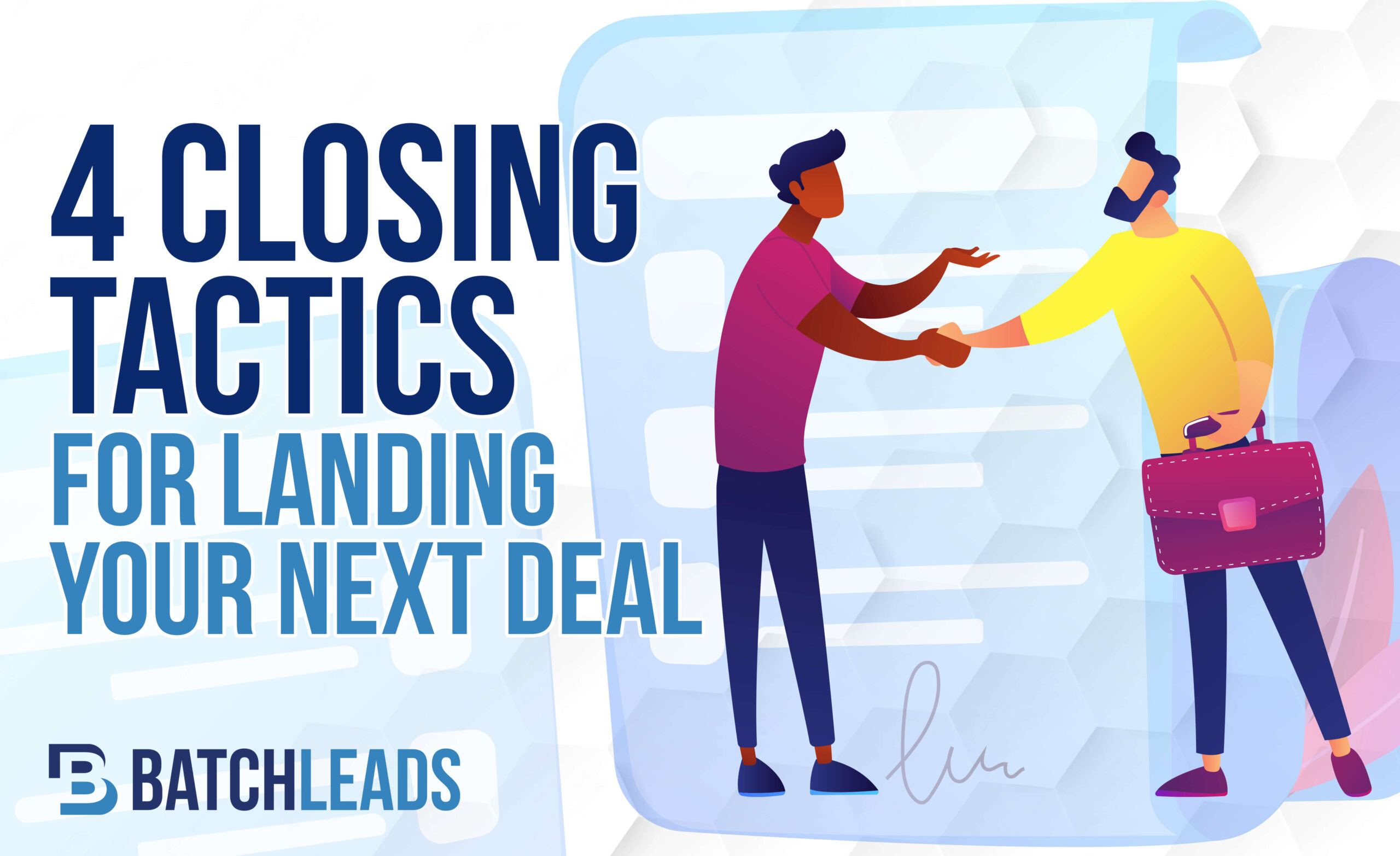You’re standing in front of the property owner, contract in hand. You’ve comped the deal and calculated the ARV. You even have a cash buyer on hand. He’s expecting a call any minute now because he’s ready to latch on. Everything about this deal is perfect.
But the property owner is kicking the can down the road at the last second. She isn’t really sure about your offer, even though you’ve discussed it several times. You feel like you could go crazy! If she would just sign the paper, you’ll finally have done it; you’ll have landed the deal you’ve been looking for. But with every second that passes, the deal feels like it’s getting farther away.
What do you do in this situation? How do you close a deal when you thought it was certain but you can’t seem to get it across the finish line?
Here are 4 professional closing tactics to keep in your arsenal for the next time you’re in this situation.
The Yes or Yes
In the Yes or Yes close, there’s only one real answer the motivated seller can give. Like a bad Choose Your Own Adventure novel, you design your questions and options so they all lead to the same outcome: the close.
There are a few ways to set this up. The first way is to ask a series of questions that the seller will answer yes to. This will require some rapport and relationship building, but once you know what the seller wants, it’s easy to do.
After you ask a series of “yes” questions, tack your offer onto the end. This tactic shows the seller that your offer lines up perfectly with the things they want in the first place, making a “yes” to your offer the logical final answer.
Another way to use the Yes or Yes close is to give the seller control of the conversation by offering two or more options, all of which lead to the close. This can be tricky to set up, since the details, options, and questions will depend on your conversations with each seller. But it’s a very strong tactic, because it gives them options to choose from, even if the outcome is the same.
One way to use this close is to start with a question like “Would you rather sell as-is or do repairs and then list this property?” If they say they’d like to do repairs, give them an honest breakdown of what the repairs will cost. Then show them what they could pocket immediately if they sell. You’ve given them an option, but the better, easier one is to sell the property to you.
You may have to create multiple pieces to this Yes or Yes funnel, but this tactic works for a few reasons. First, you can use your knowledge of their situation and motivations to ask questions that are tailored to their needs. Second, the seller will feel in control of negotiations. Everyone wants to be in control, and when sellers feel like they have options, they’ll automatically have a desire to pick one, even if both options lead to the sale.
Just be sure to craft your options/questions carefully. You don’t want to mention or highlight the third option: backing out of the deal entirely.
The Stealth Close
The stealth close, also known as the soft close, is extremely effective, and we all know it from personal experience. Have you ever gone to a website, YouTube video, or conference for information and left with a receipt for something you weren’t going to buy in the first place? Someone probably hit you with a soft close.
Instead of a standard sales pitch, a soft close doesn’t feel pushy, pressuring, or even obvious. It just gives you the option to make a purchasing decision.
For example, some soft closes are just low-pressure pitches where the salesperson maintains rapport and offers the sale as an option. Other soft closes, known as stealth closes, offer something valuable, such as education or a story, for free. Then at the end, you’re presented with the option to buy something that helps you apply your new knowledge or learn something else at an incredible value. You’ve probably encountered this close at the end of a very engaging, story-based email before. The close usually starts with the words “By the way…”
In our recent article on excellent cold calling openers, we talked about how giving away something valuable for free is a great way to get on-site and see a property. It’s also a great way to deliver a stealth close. Whether you’re estimating repair costs on a distressed property or helping the owner figure out their pre-foreclosure situation, free advice creates a great transition into “By the way, if you’re not interested in following this plan we created, you could sell your property to me.” Not only are you presenting an even easier option for the property owner, but you’re also giving a low-pressure pitch that won’t make you sound like a used car salesman.
The Takeaway
Have you ever passed up a sweet opportunity because there was just one thing about it that didn’t work for you? If that one factor had been removed, what would you have done?
Keep that situation in mind. If a seller tells you something is getting in the way of the deal, remove the roadblock! By the time you get to negotiations, the owner wants to sell. So don’t let something you can control kill the deal. If the issue is with your terms, offer, or timeline, fix the situation so it works for both of you. You can’t resolve every situation, but you’ll be surprised what you can do when you try. And if the seller sees that you’re willing to work with them, they’ll be much more likely to do business with you.
Another great way to use this closing technique is to make an initial offer you know the owner will reject. When they reject it, remove the bad part of the deal and come back with the offer you want them to agree on. This could involve raising your offer price, changing the terms of your offer, removing repair requirements, etc.
This is a highly successful sales technique that is often used in non-profit fundraising and high-ticket sales. It works because the first offer seems so bad that it makes the second offer seem amazing in contrast.
You have to be careful of course. If the first offer is obviously fake or bad, you’ll ruin the deal. You also can’t use this to harass or pressure the owner. Don’t threaten to remove parts of the deal if they don’t agree to your terms, and don’t try to manipulate the situation. But if you can use the right sales tactics to make signing easier and more appealing, your leads will be running to grab a pen before you know it.
The List
Here’s some marketing 101: people take actions that they think will benefit them. We’re always asking “What’s in it for me?” So if you haven’t told your leads how selling will help their specific situations, they’re not going to sell to you.
And don’t assume they already know about the benefits. Tell them. Will they avoid repairs? Will they have a quicker closing? Will they avoid working with a real estate agent? Whatever you highlight, just make sure they know all the great things they’ll get out of the process. Otherwise, they’ll think this is all about you and the money you’re going to make from their home.
Bonus: The Walk
As a bonus, here’s a tactic that you’ll need to use sometimes: the ability to walk away. We’ve talked about this before, but negotiating back and forth on price and terms can quickly become a waste of your time. If you’re cutting your profit margin down again and again just to close the deal, you’re not making a good decision. Not only are you leaving money on the table, but you’re also losing time that you could use to land bigger, better deals. Plus the more you raise your offer, the more the seller will realize that they can talk you into paying an even higher price for the property.
Walking away can also show the seller that the deal is at risk. It shows them that if they aren’t willing to agree to your terms, they may lose the chance to get out of their bad financial situation. It’s like an alarm clock going off, and it shows them that they need to make a decision.
You shouldn’t use this tactic as a threat of course. That will kill the deal immediately. But if the seller isn’t interested in accepting your offer and you feel like you’re wasting time, move on. It’s always better to cut your losses than to extend them.
Summary
If you go into negotiations without knowing how to close a deal, you’re not going to have a good time. Not only do you run the risk of losing the deal at the last moment, but you may also find yourself with no idea what to do once you get to the big moment. Thankfully, with these tactics, you’ll have several strategies in your arsenal if your next deal starts to stagnate.
Of course, you can’t use closing tactics if you don’t have a regular flow of reliable leads. How are you going to close a deal if you can’t find one? And how will you know how much to offer if you don’t have reliable comping info? WithBatchLeads, you don’t have to worry about that ever again.
Not only can you instantly establish your personal real estate lead flow, but you can also compare your deal to comparable properties, all from the app! Investors on BatchLeads are landing more deals than investors on any other platform, and they’re doing it at lightning-fast speeds.
To help you get started putting these closing tactics to use, we’re offering a free 7-day trial of BatchLeads plus 5,000 complimentary property records! Just click here to redeem it!
Don’t keep yourself from the action. Get started today!



